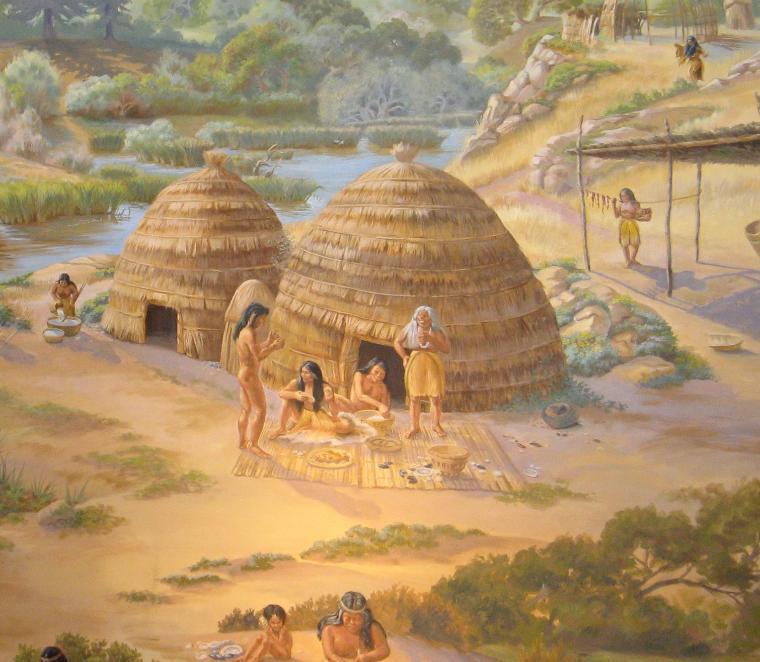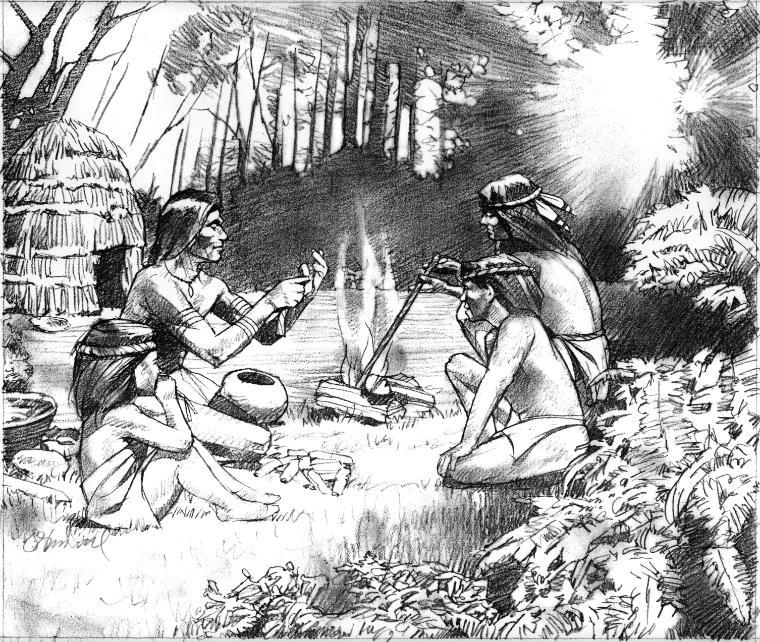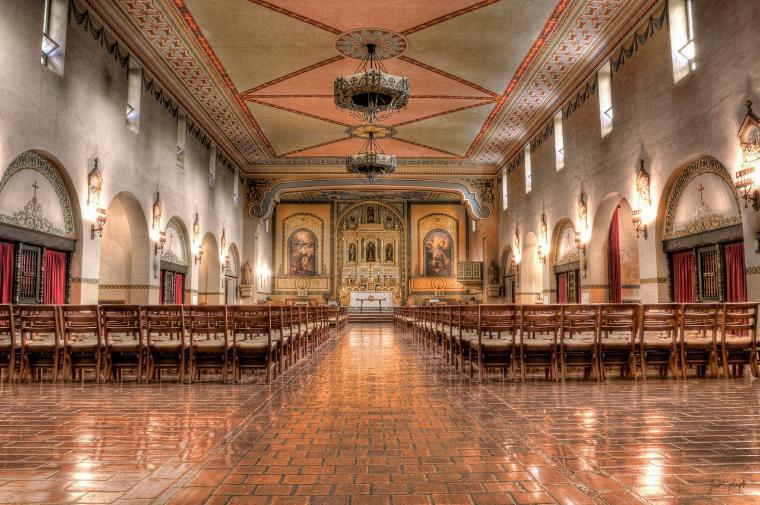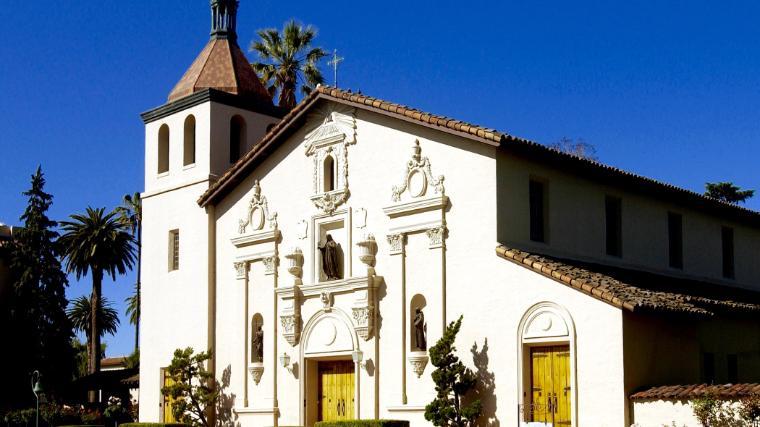The History of Mission Santa Clara
The Ohlone

Long before the arrival of the first Europeans, the South Bay was home to a large native population—numbering 10,000 people. They had occupied the Bay Area for thousands of years divided into as many as 40 independent tribes. One such community, called Thamien, was located where the SCU campus now stands. Today, descendants call themselves “Ohlone”.
The Ohlone lifestyle can be described as “hunter-gatherer”. Though they did not cultivate crops or herd domestic animals, they used sophisticated landscape management practices, including prescribed burns, to make a living in the fertile south bay region. They lived in numerous settlements of 200 to 500 persons spread throughout the broad "Valley of Oaks” enjoying a diet of fish, shellfish, water fowl, venison, acorns, rabbit, and wild berries. From the tule reeds found near water’s edge they made their houses and boats and they wove baskets from the native sedge grasses. Ohlone religion revolved around elaborate ritual dances with dancers wearing colorful regalia and tribal members communing in the tribal sweat lodge—for ensuring good hunts, healing illness and expelling impurities.
This way of life had sustained the Ohlone for thousands of years, but the onset of Spanish colonization in 1769 introduced dramatic changes. Over the course of several generations, Ohlone society shifted from a traditional focus on hunting and gathering to agriculture; from holding strict tribal identities to having blended “mission” identities; from their native worldview to becoming, at least outwardly, Catholic Christian converts and citizens of the Spanish Empire. How could this happen?
Franciscan conversion practices began largely through attraction rather than conquest: starting with strategic trade and outright gifts. Yet, once individuals joined the mission they were not allowed to leave. Sadly, historical accounts reveal harsh punishments (by modern standards) of withholding food, corporal punishments, and imprisonment for wayward converts. Yet, there was another motivator for joining the mission: namely, the increasing scarcity of native game and foods brought about by the herds of cattle, horses, sheep, pigs, and goats imported by the Spanish. Over-grazing of the native grasses and growing displacement of the native game gave the mission an increasing monopoly over the local food supply. Eventually, the new trade skills of ranching, farming, tanning, adobe brick and tile making came to be seen as necessary skills for survival.

Considering the number of converts and productivity, the padres proclaimed Mission Santa Clara an early success. Yet, this success proved fleeting. Weakened by the clash of cultures and waves of epidemics: chiefly small pox and measles, the Ohlone population dwindled by 1830 to 2,500 people. Mexican independence from Spain in 1822 only hastened the collapse of the mission system and undermined the planned return of mission land ownership to the Ohlone. The California Gold Rush, brought waves of prospectors and pioneers--along with unscrupulous wheeler-dealers--pushing the remaining Ohlone to the margins of California society.
However, the Ohlone people did not disappear. Numerous family groups have reclaimed their heritage and are seeking Federal recognition in our time.
From Mission to University
The story now turns to Mission Santa Clara de Asis, the 8th mission in the chain of 21 Franciscan missions established by Padre Junipero Serra. It was first founded January 12, 1777 on the banks of the Guadalupe River (just north of Hwy 101, opposite the Mineta International Airport) and the first to bear the name of a woman, St. Claire of Assisi, an early companion of St. Francis. Flood, fire and earthquake forced five relocations until the Mission finally settled on this current site in 1822.

From the start, Mission Santa Clara was meant to serve as the sister mission to Mission Dolores in San Francisco. Spanish Viceroy Bucareli’s grand design intended Mission Dolores (and its Presidio) to anchor the mouth of San Francisco Bay with Mission Santa Clara anchoring the South Bay--receiving goods and services meant for the new Pueblo of San Jose.
Mission Santa Clara seemed to thrive at first: boasting the highest number of converts and recording record productivity made possible by the fertile, well-watered lands and temperate climate. But this was not to last.
The always present clash of cultures, epidemics and growing rivalries with the nearby Pueblo of San Jose were only made worse by Mexico’s secession from the Spanish Empire in 1822, when royal funding completely dried up. At the secession, the fledgling Mexican government found few resources for supporting such distant missions. By the end of the 1830’s, the new government secularized all 21 missions (i.e. they reverted the mission lands to Ohlone ownership) and expelled the Spanish Franciscans loyal to the King of Spain and inadvertently abandoned the Ohlone to the pioneers and the profiteers.
With insufficient funds to maintain the complex, and a single priest to operate the Mission as a parish church, the property fell into serious decay. In 1850, Bishop Joseph Alemany approached a Jesuit priest, Fr. John Nobili, S.J., to turn the parish and its adjacent lands into a college. This meant transferring the property from Franciscan ownership to Jesuit ownership. So on March 19, 1851, Mission Santa Clara became the first college of higher learning in the new state of California.

Soon after, the new college president, Burchard Villager, S.J., began a rebuilding campaign to upgrade the campus’ decrepit buildings. Fr. Burchard also enlarged the Mission Church giving it a new facade. For a while, the building boasted an Italianate façade--with two bell towers-- all made of wood (similar in style to St. Joseph’s Cathedral in San Jose). A devastating fire in 1926 totally consumed this remodeled building. It was decided to rebuild its replacement not in the style of the remodeled, Italianate building but in the idealized neo‑colonial style fashionable at the time. Drawing from actual historical photographs, they resurrected more of the original 1825 single bell tower structure. This is the building you see today: similar in length but twice as wide as the 1825 Mission and more sophisticated in detail. Fortunately, the building was also built of steel reinforced concrete--rather than adobe brick--making it much more resistant to earthquakes and fire.
Today Mission Santa Clara continues to serve as Santa Clara University’s student chapel while its image has become the icon for the local county, city, and university bearing its name.
To download this narrative and view other helpful materials, click here.